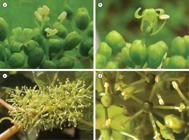Abstract
Phenology and reproductive biology of cultivated species are important for the comprehension of the requirements for fruit and seed production and the management of pollinators. This study aimed to characterise the phenology, reproductive biology and growing degree days of the grapevine ‘Isabel’ (Vitis labrusca) in northeastern Brazil during January 2011 (P1), Augst 2011 (P2), April 2012 (P3) and August 2012 (P4). We recorded the duration (days) of the phenological stages, pruning (P), woolly bud (W), budburst (B), inflorescence development (ID), flowering (F), ripening (R) and harvest (H). We analysed the floral biology, the sexual system and the breeding system. We measured the growing degree days (GDD) required to reach the subperiods P-B, B-F and F-H. The periods P1, P2, P3 and P4 lasted for 116, 125, 117 and 130 days, respectively. The number of days of harvest were similar in the same dry (P1 and P3) and rainy (P2 and P4) periods. All the periods that we recorded were shorter than those observed in other regions of Brazil, which may be attributable to the mean temperature and carbohydrate metabolism. The flowers are green, hermaphroditic, with an odour of mignonette, low pollen viability and autogamous. The base temperature of 10°C was considered the most adequate for the subperiods as has been documented for other grape varieties in Brazil. Thus, temperature was also the most adequate for the cycles, presenting a smaller standard deviation (0.119, 0.147, 0.156 and 0.153 to P1, P2, P3 and P4, respectively) when compared to a base temperature of 12°C (0.122, 0.158, 0.165 and 0.160 to P1, P2, P3 and P4, respectively). The higher and the lower observed GDD were 1972.17 and 1870.05, respectively, both above the values recorded in other parts of Brazil for same variety. The phonological results, including knowledge of growing degree days, are important to the planning of cultures at the study site and in other regions that have similar climatic conditions and make it possible to pre-determine the harvest.
Keywords:
breeding system; heat unit; grape; phenology; GDD

 Thumbnail
Thumbnail
